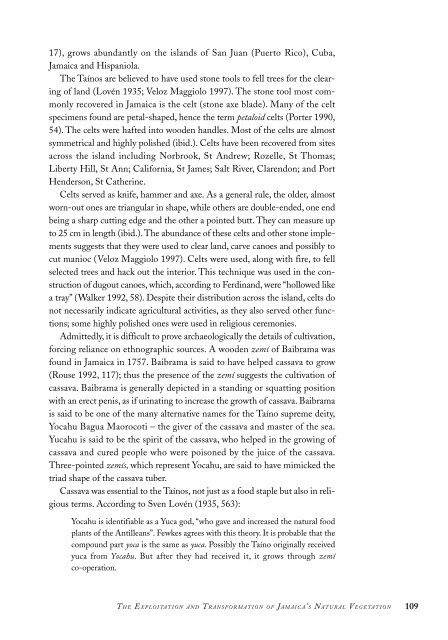The Earliest Inhabitants: The Dynamics of the Jamaican Taino
by Lesley-Gail Atkinson
by Lesley-Gail Atkinson
Create successful ePaper yourself
Turn your PDF publications into a flip-book with our unique Google optimized e-Paper software.
17), grows abundantly on <strong>the</strong> islands <strong>of</strong> San Juan (Puerto Rico), Cuba,<br />
Jamaica and Hispaniola.<br />
<strong>The</strong> Taínos are believed to have used stone tools to fell trees for <strong>the</strong> clearing<br />
<strong>of</strong> land (Lovén 1935; Veloz Maggiolo 1997). <strong>The</strong> stone tool most commonly<br />
recovered in Jamaica is <strong>the</strong> celt (stone axe blade). Many <strong>of</strong> <strong>the</strong> celt<br />
specimens found are petal-shaped, hence <strong>the</strong> term petaloid celts (Porter 1990,<br />
54). <strong>The</strong> celts were hafted into wooden handles. Most <strong>of</strong> <strong>the</strong> celts are almost<br />
symmetrical and highly polished (ibid.). Celts have been recovered from sites<br />
across <strong>the</strong> island including Norbrook, St Andrew; Rozelle, St Thomas;<br />
Liberty Hill, St Ann; California, St James; Salt River, Clarendon; and Port<br />
Henderson, St Ca<strong>the</strong>rine.<br />
Celts served as knife, hammer and axe. As a general rule, <strong>the</strong> older, almost<br />
worn-out ones are triangular in shape, while o<strong>the</strong>rs are double-ended, one end<br />
being a sharp cutting edge and <strong>the</strong> o<strong>the</strong>r a pointed butt. <strong>The</strong>y can measure up<br />
to 25 cm in length (ibid.).<strong>The</strong> abundance <strong>of</strong> <strong>the</strong>se celts and o<strong>the</strong>r stone implements<br />
suggests that <strong>the</strong>y were used to clear land, carve canoes and possibly to<br />
cut manioc (Veloz Maggiolo 1997). Celts were used, along with fire, to fell<br />
selected trees and hack out <strong>the</strong> interior. This technique was used in <strong>the</strong> construction<br />
<strong>of</strong> dugout canoes, which, according to Ferdinand, were “hollowed like<br />
a tray” (Walker 1992, 58). Despite <strong>the</strong>ir distribution across <strong>the</strong> island, celts do<br />
not necessarily indicate agricultural activities, as <strong>the</strong>y also served o<strong>the</strong>r functions;<br />
some highly polished ones were used in religious ceremonies.<br />
Admittedly, it is difficult to prove archaeologically <strong>the</strong> details <strong>of</strong> cultivation,<br />
forcing reliance on ethnographic sources. A wooden zemí <strong>of</strong> Baibrama was<br />
found in Jamaica in 1757. Baibrama is said to have helped cassava to grow<br />
(Rouse 1992, 117); thus <strong>the</strong> presence <strong>of</strong> <strong>the</strong> zemí suggests <strong>the</strong> cultivation <strong>of</strong><br />
cassava. Baibrama is generally depicted in a standing or squatting position<br />
with an erect penis, as if urinating to increase <strong>the</strong> growth <strong>of</strong> cassava. Baibrama<br />
is said to be one <strong>of</strong> <strong>the</strong> many alternative names for <strong>the</strong> Taíno supreme deity,<br />
Yocahu Bagua Maorocoti – <strong>the</strong> giver <strong>of</strong> <strong>the</strong> cassava and master <strong>of</strong> <strong>the</strong> sea.<br />
Yucahu is said to be <strong>the</strong> spirit <strong>of</strong> <strong>the</strong> cassava, who helped in <strong>the</strong> growing <strong>of</strong><br />
cassava and cured people who were poisoned by <strong>the</strong> juice <strong>of</strong> <strong>the</strong> cassava.<br />
Three-pointed zemís, which represent Yocahu, are said to have mimicked <strong>the</strong><br />
triad shape <strong>of</strong> <strong>the</strong> cassava tuber.<br />
Cassava was essential to <strong>the</strong> Taínos, not just as a food staple but also in religious<br />
terms. According to Sven Lovén (1935, 563):<br />
Yocahu is identifiable as a Yuca god, “who gave and increased <strong>the</strong> natural food<br />
plants <strong>of</strong> <strong>the</strong> Antilleans”. Fewkes agrees with this <strong>the</strong>ory. It is probable that <strong>the</strong><br />
compound part yoca is <strong>the</strong> same as yuca. Possibly <strong>the</strong> Taíno originally received<br />
yuca from Yocahu. But after <strong>the</strong>y had received it, it grows through zemí<br />
co-operation.<br />
T HE E XPLOITATION AND T RANSFORMATION OF J AMAICA’ S N ATURAL V EGETATION<br />
109


















